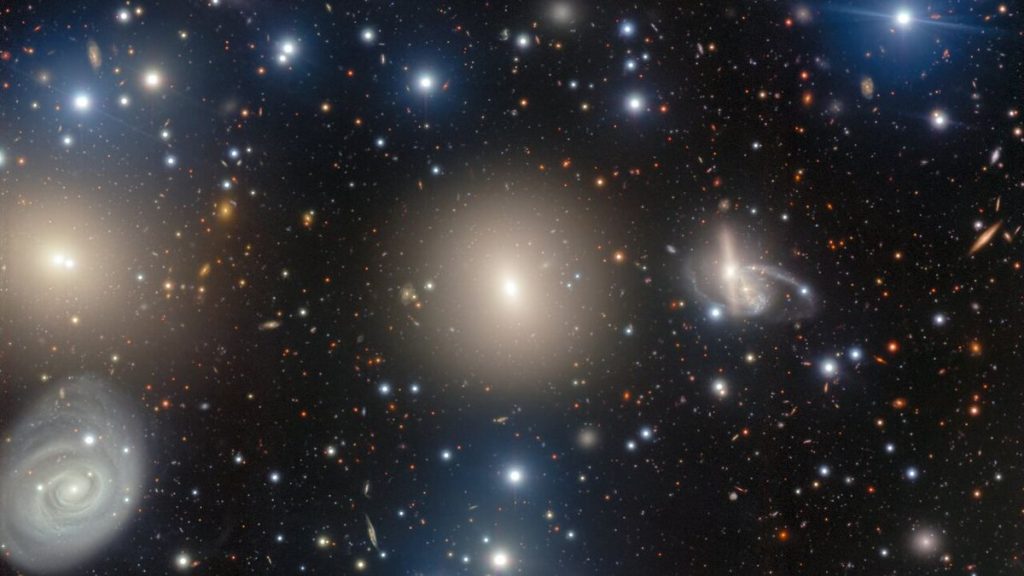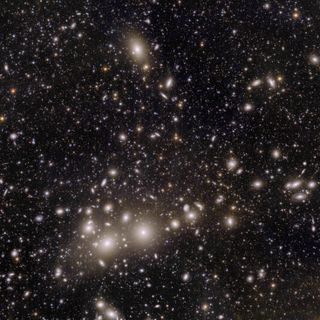
Massive, bustling Perseus galaxy cluster dazzles in new telescope image (Image Credit: Space.com)
This scene of cosmic chaos shows a section of the immense Perseus galaxy cluster, revealing several giant elliptical galaxies, a dusty spiral whose arms are fading, and several edge-on galaxies, some of which appear to be experiencing interactions or mergers with their neighbors.
And this is just a small part of the galaxy cluster, which resides between 240 and 250 million light-years from Earth and contains thousands of galaxies.
Imaged by the Gemini North telescope on Mauna Kea in Hawaii, the giant elliptical galaxy at the center of the image is NGC 1270. The galaxy has long since given up the ghost in terms of forming new stars; all that reside in NGC 1270 now are old, cool, red stars, giving the elliptical galaxy its distinct hue. Lurking at its heart is an active supermassive black hole, with up to 12 billion times the mass of our sun.
NGC 1270 is one of the most massive galaxies in the Perseus Cluster, but it doesn’t quite match the stature of another elliptical galaxy in the cluster, namely NGC 1275. Lying outside the field of view of this Gemini North image, NGC 1275 is what’s called the Brightest Cluster Galaxy, or BCG. It’s a true giant at the heart of the Perseus Cluster and it’s still growing, with 13 billion solar masses of hydrogen gas falling onto it from the cluster environment at large. Indeed, computer simulations suggest that up to 70% of the mass of the BCG — and others like it in all clusters — comes from material that has become caught up in their cluster’s gravitational web and fallen toward the cluster’s center, where it is accreted onto the BCG.
Related: World’s largest visible-light telescope spies a galaxy cluster warping space-time
NGC 1275 lies at the very center of mass of the cluster. It’s the hub around which all this galactic chaos unfolds. Surrounding it is a faint halo of diffuse light produced by stars, torn from galaxies falling into the cluster by the gravitational tides that wash through the environment. It’s not just individual stars that are ripped away; the European Space Agency‘s Euclid spacecraft recently detected 70,000 free-floating globular clusters within the central 1.6 million light-years of the cluster.
This diffuse halo of light is referred to as the intra-cluster light, or ICL. Although the ICL and the BCG have somewhat similar origins, in that most of their mass comes from material torn from other galaxies falling into the cluster, they are not connected. The center of the ICL is offset from the center of NGC 1275 by about 200,000 light-years, meaning that the BCG and the ICL are distinct, but overlapping. The stars in the ICL also move on different paths to the stars in NGC 1275 and contain different amounts of heavy elements. Dwarf galaxies were thought to be the source of the stars that collectively produce the ICL, but there are too few dwarf galaxies in the Perseus Cluster — Euclid counted about 1,100 — to explain the brightness and extent of the ICL. Instead, slightly more massive galaxies are probably the source.
The Perseus Cluster isn’t just filled with the intra-cluster light. There’s something else, called the intra-cluster medium, which is a swamp of diffuse gas through which the cluster’s galaxies have to wade. As galaxies careen through this intra-cluster medium, the pressure of them ramming the gas acts to strip out all their star-forming molecular hydrogen. Spiral galaxies are therefore left like the dusty spiral seen on the far left in this image, where all their star-forming gas has gone so they can’t produce new stars, and as older stars die and spew out their innards, the galaxy becomes chock-a-block with interstellar dust.
The intra-cluster medium is hot, in excess of 1.8 million degrees Fahrenheit (1 million degrees Celsius), so hot that it radiates strongly in X-rays. NASA‘s Chandra X-ray Observatory has seen bubbles being blown into this X-ray background by outbursts from the 800-million-solar-mass supermassive black hole at the core of NGC 1275. The bubbles produce large-amplitude ripples that reverberate through the intracluster medium. Although not literally audible, scientists have converted these pressure waves into sound waves, finding them to be one of the deepest sounds ever heard, a note 57 octaves below the middle keys on a piano. The bubbles in the Virgo galaxy cluster produce an even deeper note, 59 octaves below!
The Perseus Cluster, with a total mass of 665 trillion times the mass of our sun, is one of the most massive nearby galaxy clusters. It’s part of the Perseus-Pisces Supercluster, which is made up of three individual galaxy clusters, and there’s an estimated 10 million superclusters in the visible universe. Galaxy clusters and superclusters form at the nodes of the great cosmic web of matter that spans the universe.
This cosmic web was produced in the aftermath of the Big Bang, when ripples in the sea of plasma that filled the universe until 379,000 years after the Big Bang froze in place. The ripples were sites of slightly greater density, and hence gravity, and over time they have attracted matter to them, and today the ripples form the filaments of the cosmic web, and are made mostly of dark matter. Indeed, when we look at a galaxy cluster, we can’t see most of the mass, not even in X-rays— about 85% of each cluster is invisible dark matter. We can infer its presence by looking for where dark matter’s gravity has created gravitational lenses.
Nevertheless, the 15% that we can see is wondrous, as typified in the Gemini North image, full of color, action and chaos.






